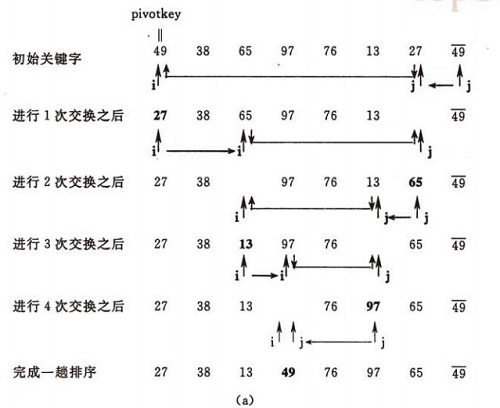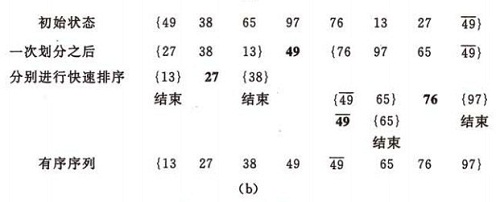1.基本思想:
它采用了一种分治的策略,通常称为分治法。
分治法思想:将原问题分解为若干个规模更小但结构与原问题相似的子问题。递归地解这些子问题,然后将这些子问题的解组合为原问题的解。
对于数组A, 随机选择一个元素作为基准数pos,一般为第一个元素或最后一个元素。
将该数组分为两堆A[0,pos_index-1] 和 A[pos_index+1,n],一堆元素全都小于pos ,另一堆元素全都大于pos ,pos_index 为基准素的下标。
按照分治思想,左右两堆分别进行快排递归操作,即QuickSort(A, 0, pos_index -1) 和 QuickSort(A, pos_index +1 , n) 。
1)一趟排序过程:
2)整个排序过程:
2.算法分析:
平均时间复杂度: O(nlog2n) 最坏(有序情况下):O(n^2)
空间复杂度: O(logn) 最坏 O(n)
稳定性: 不稳定
3.算法实现:
public static int partition(int[] array,int l, int r){ int pos = array[l]; while(l<r){ //从右往左找出比基准数小的下标r while(l < r && array[r] >= pos) r--; // 与基准数交换 array[l] = array[r]; //从左往右找出比基准数大的下标l while(l < r && array[l] <= pos) l++; array[r] = array[l]; } array[l] = pos; return l; } public static void QuickSort(int[] array,int l, int r){ if(l<r){ //确定基准数在一次遍历后的下标,左右两边递归进行 int t = partition(array,l,r); QuickSort(array,l,t-1); QuickSort(array,t+1,r); } }
4.算法优化:1.只对长度大于k的子序列递归调用快速排序,让原序列基本有序,然后再对整个基本有序序列用插入排序算法排序。详见 http://blog.csdn.net/naruto_ahu/article/details/81920392. 通过随机选择初始基准数,使得当面对有序序列时,时间复杂度也为O(nlog2n);同时,去掉了没有必要的对基准数值的来回交换,只需要最后的时候放到目标位置上就可以了。<span style="white-space:pre"> </span>public static int partition1(int[] array,int l, int r){ int index = (int) (Math.random() % (r - l+1) + l); int pos = array[ (int) (Math.random() % (r - l+1) + l)]; while(l<r){ //从右往左找出比基准数小的下标r while(l < r && array[r] >= pos) r--; // 与基准数交换 array[index] = array[r]; index = r; //从左往右找出比基准数大的下标l while(l < r && array[l] <= pos) l++; array[index] = array[l]; index = l; } array[l] = pos; // 将基准数放入最后所求分割位置 return l; } public static void QuickSort(int[] array,int l, int r){ if(l<r){ //确定基准数在一次遍历后的下标,左右两边递归进行 int t = partition1(array,l,r); QuickSort(array,l,t-1); QuickSort(array,t+1,r); } }


























 123
123

 被折叠的 条评论
为什么被折叠?
被折叠的 条评论
为什么被折叠?








